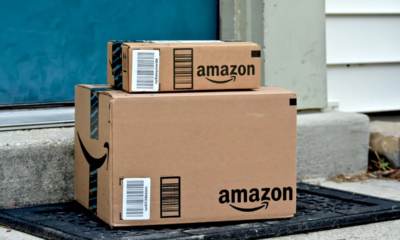Internet
The latest space race is all about improving Internet access. Here’s what you should know.

Satellite Internet isn’t very good, but SpaceX and Amazon are hoping to change that.
These companies are trying to go after an estimated 4 billion people without access to the Internet as well as businesses that operate in remote areas such as airlines and cruise ships.
It’s still unclear how those big-picture plans will ultimately shake out, but Starlink is already live and serving around 90,000 customers around the world. In the past, others have tried and failed to do just what SpaceX, Amazon and OneWeb are hoping to accomplish. Teledesic, a company partly funded by Bill Gates in the mid-1990s, failed after costs soared into the billions. Attempts by Iridium and Globalstar failed after both ended up in bankruptcy. OneWeb also filed for bankruptcy before emerging last year. Musk has said he’s aware of that history and that the success of Starlink was not guaranteed. But he has the advantage of being able to launch the satellites on SpaceX’s reusable Falcon 9 rockets.
As lawmakers work out how to extend broadband Internet to parts of the country that need it most, a new generation of satellites may be able to help keep some families in rural areas connected and their kids educated — for a price.
Here’s what you need to know about how these new Internet services work.
Satellite Internet services have been around for a long time and estimates from the U.S. Census Bureau in 2019 suggest around 8 million Americans rely on them to stay connected. But the experience can be far from pleasant. In many cases, satellite Internet is much slower than what a cable company can offer and many providers enforce stringent limits on how much data you can comfortably use. So why do people use it? For many, especially those in rural or hard-to-reach areas, it’s because they don’t have other options.
Incumbents like HughesNet and Viasat have been slinging satellite Internet service in the United States for years and have parked their satellites in high, geostationary orbits — think 22,000 miles from the ground or so. That means fewer satellites are required to cover lots of land, but there’s a catch. Signals beamed to these satellites and back are bound by the speed of light, and the kinds of round-trip distances involved here mean latency, commonly known as lag, is unavoidable.
Meanwhile, upstarts like Musk’s Starlink project take a different approach; instead of relying on a handful of satellites in high orbits, it uses lots of satellites in lower ones — some are as low as 340 miles over your head. Because they’re physically closer to the earth, it doesn’t take as long for data to move from your home to a satellite to a wired ground station and back.
And by “lots of satellites,” we mean thousands. Starlink currently has more than 1,700 satellites circling the planet and aims to light around 10,000 more. Meanwhile, Amazon is planning a similar approach with its Project Kuiper and hopes to get a total of 3,236 satellites into low-earth orbit, but so far hasn’t gotten any of them off the ground.
Let’s make one thing clear, though: services like Starlink really aren’t meant to be used in densely populated towns or cities. Reliable, wired Internet connections are far more common there, and while those residents have their own issues — more than 80 million Americans only have access to one high-speed Internet service provider, according to a study published by the Institute for Local Self-Reliance — they generally don’t have as much trouble getting online. Ultimately, it’s people in rural and lightly inhabited regions that stand to gain the most from these constellations of new satellites.
Services like Starlink have tremendous potential to help people without reliable Internet access tap into everything the web has to offer. But they aren’t without their downsides.
For one, they’re still subject to some of the natural limitations other satellite Internet companies have had to deal with. Heavy rain or wind can lead to some disturbances in service and Starlink has recommended in the past that people take their 23-inch dishes inside if winds get seriously scary. Scientists — especially astronomers — have also raised concerns over the impact that putting tens of thousands of satellites into orbit could have on their ability to peer into space.
But for the people who really need better Internet access, there’s at least one big knock against services like Starlink: the wait. Around 90,000 people currently use Starlink for Internet access, many of whom live in the United States, according to an informal poll conducted on Reddit. But there’s also demand from would-be customers overseas, and it’s tough to tell how quickly the service will expand its reach to serve everyone who wants it. Some people who signed up to preorder their Starlink dishes were told that their areas would get service in late 2021, while others would have to wait until some time in 2022 or 2023. Meanwhile, those looking to Amazon to step up are in for an even longer wait — it’ll be a while before Project Kuiper even resembles a viable alternative.
HughesNet, the largest satellite Internet service provider in the United States, charges around $450 for the necessary equipment, though customers can lease it for a smaller monthly fee. And before promos kick in, the company’s plans range from $60 per month for 10GB of full-speed access to $150 per month for 50GB.
There are a few issues here. For one, those data caps can make life difficult, especially in the age of remote learning and frequent video calls. The company says that once you tiptoe over those data limits, you won’t be completely cut off — your speeds just drop from the advertised 25 megabits per second (Mbps) to between 1-3 Mbps. That can still be better than DSL (digital subscriber line) in some edge cases, but it’s downright glacial by 2021 standards. (In fairness, HughesNet also gives its customers 50GB of extra data to use each month, but only between the hours of 2 a.m. and 8 a.m.).
Viasat is a little different in that it offers customers tiers of service based on spSet featured imageeed. Generally, the more you pay, the faster your Internet. (What makes things confusing is that Viasat offers different Internet speeds and plans depending on where you live.) But it’s similar to HughesNet in that those speeds can and will be slowed, or “throttled,” if you download or stream or game too much. Exactly how much depends on your plan, but the message is still clear: you still need to be mindful of what you and your family use the Internet for.
By comparison, Starlink feels like a breath of fresh air. The SpaceX division says customers can expect download speeds between 100 Mbps and 200 Mbps from its only service plan, which costs $99 per month. Customers also have to shell out $499 for a base station they’ll have to set up themselves. (Thankfully, the Starlink companion app seems to walk people through the process without much fuss.)
Those advertised speeds are much faster than what the incumbents offer, but there’s another big difference here: Starlink doesn’t have a cap on how much high-speed data you can use. It’s possible that could change as more people start accessing the network. For now, though, that lack of limitation can make the service seriously appealing for anyone who doesn’t have access to a more reliable, wired connection.
And so far, the speed test is on Starlink’s side. The network testing firm Ookla reported in August that the service’s median speed was 97.23 Mbps — that’s plenty for streaming, gaming, video chats and more. Meanwhile, the median results from HughesNet and Viasat were less than a quarter of Starlink’s and slower than what the Federal Communications Commission would define as broadband Internet.
For its part, Amazon hasn’t confirmed what it plans to charge for Internet access via Project Kuiper, or whether people will have to sign up directly or through a reseller. The company has pointed out in some of its tests that download speeds were as high as 400 Mbps, which could make for more reliable video calls and distance learning sessions. Still, there are two things to keep in mind here. First, once people start using Kuiper’s service, you almost certainly won’t see speeds that high consistently. And second, Kuiper as a service doesn’t exist yet, and likely won’t for at least a few years.
Source: https://www.washingtonpost.com/technology/2021/11/02/satellite-internet-starlink-kuiper-faq/







